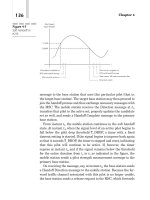SELF-REGULATORY PRINCIPLES FOR ONLINE BEHAVIORAL ADVERTISING potx
Bạn đang xem bản rút gọn của tài liệu. Xem và tải ngay bản đầy đủ của tài liệu tại đây (1.81 MB, 48 trang )
OVERVIEW
The cross-industry Self-Regulatory Program for Online Behavioral Advertising was
developed by leading industry associations to apply consumer-friendly standards
to online behavioral advertising across the Internet. Online behavioral advertising
increasingly supports the convenient access to content, services, and applications over
the Internet that consumers have come to expect at no cost to them.
The Self-Regulatory Program consists of seven Principles. These Principles, described
below, correspond with the “Self-Regulatory Principles for Online Behavioral Adver
-
tising” proposed by the Federal Trade Commission in February 2009, and also address
public education and industry accountability issues raised by the Commission.
SCOPE AND APPLICATION
The Principles are intended to apply broadly to the diverse set of actors that work in
-
terdependently to deliver relevant advertising intended to enrich the consumer online
experience. Many of the entities and practices to which they apply are covered by self-
regulatory principles for the first time in this area.
The Principles apply to online behavioral advertising, defined as the collection of
data online from a particular computer or device regarding Web viewing behaviors
over time and across non-affiliate Web sites for the purpose of using such data to
predict user preferences or interests to deliver advertising to that computer or device
based on the preferences or interests inferred from such Web viewing behaviors. The
Principles do not apply to a Web site’s collection of viewing behavior solely for its own
uses. Contextual advertising also is not covered by the Principles as it delivers adver
-
tisements based on the content of a Web page, a search query, or a user’s contempora
-
neous behavior on the Web site.
THE PRINCIPLES
calls for entities to participate in efforts to educate consumers
and businesses about online behavioral advertising. It is expected that there will exist
a robust industry-developed Web site(s) that provide consumers with educational
material about online behavioral advertising. Additionally, it will result in numerous
online impressions educating the public about how online behavioral advertising
works and the choices that are available to consumers.
requires the deployment of multiple mechanisms for clearly
disclosing and informing consumers about data collection and use practices associated
with online behavioral advertising. This Principle applies to entities collecting and
using data for online behavioral advertising and to the Web sites from which such data
is being collected and used by third parties. Compliance with this Principle will result
in new links and disclosures on the Web page or advertisement where online behav
-
ioral advertising occurs.
provides for mechanisms that will enable users of Web
sites at which data is collected for online behavioral advertising purposes the ability
to choose whether data is collected and used or transferred to a non-affiliate for such
purposes. The choice will be provided by the third party entities collecting and using
data for online behavioral advertising and the mechanism will be found either at their
own Web sites or at industry-developed Web sites. The new links and disclosures on
the Web pages or advertisements will direct consumers to these mechanisms.
The Transparency and Consumer Control Principles have separate provisions for
“service providers” engaged in online behavioral advertising. Under these Principles,
service providers must provide additional notice regarding the online behavioral ad
-
vertising that occurs by use of their services, obtain the consent of users before engag
-
ing in online behavioral advertising, and take steps to de-identify the data used for
such purposes. Internet access service providers and providers of desktop applications
software such as Web browser “tool bars” are examples of service providers under these
Principles.
requires entities to provide reasonable security for, and lim-
ited retention of, data collected and used for online behavioral advertising purposes.
directs entities to obtain consent before applying any
change to their online behavioral advertising data collection and use policy that is less
restrictive to data collected prior to such material change.
recognizes that certain data collected and used for on-
line behavioral advertising purposes merits different treatment. The Principles apply
heightened protection for children’s data by applying the protective measures set forth
in the Children’s Online Privacy Protection Act. Similarly, this Principle requires
consent for the collection of financial account numbers, Social Security numbers,
pharmaceutical prescriptions, or medical records about a specific individual for online
behavioral advertising purposes.
calls upon entities representing the wide range of actors
in the online behavioral advertising ecosystem to develop and implement policies and
programs to further adherence to these Principles. It is intended that these programs
will help ensure that all entities engaged in online behavioral advertising bring their
activities into compliance with these Principles. The Direct Marketing Association,
which has more than 3,500 members, has indicated that it will integrate the Principles
into its long-standing effective self-regulatory program. The Council of Better Business
Bureaus, with a long history of successful accountability programs, has indicated that
it is developing a new program around these Principles.
The Accountability Principle calls for programs to have mechanisms by which they
can police entities engaged in online behavioral advertising and help bring these
entities into compliance. Programs will also publicly report instances of uncorrected
violations to the appropriate government agencies.
IMPLEMENTATION OF THE TRANSPARENCY
AND CONSUMER CONTROL PRINCIPLES
For consumers, the most visible effects of the Self-Regulatory Program will result from
implementation of the Transparency and Consumer Control Principles by entities that
collect Web viewing data for online behavioral advertising purposes and by the Web
sites on which such data is collected and used. The “enhanced notice” approach re
-
quired by the Transparency Principle will offer consumers the ability to exercise choice
regarding the collection and use of data for online behavioral advertising through one
of several avenues. Links to consumer notices will be clear, prominent, and conve
-
niently located. This enhanced notice will be provided at the Web sites from which
data is collected. Such enhanced notice will be provided at the time of such collec
-
tion and use, through common wording and a link/icon that consumers will come to
recognize. The opportunity for Web site users to exercise choices about whether Web
viewing data can be collected and used for online behavioral advertising will never be
more than a few clicks away from such standardized wording and link/icon.
To implement enhanced notice, an entity that collects and uses data for online behav
-
ioral advertising purposes will provide at least two mechanisms for consumer notice.
First, an entity will provide consumer notice on its own Web site. Second, an entity
will provide consumer notice at the time that data is collected and used for online
behavioral advertising. One option for providing this second form of notice is for an
entity to attach a uniform link/icon and wording to each advertisement that it serves.
Clicking on this link/icon will provide a disclosure from the entity in the form of
an expanded text scroll, a disclosure window, or a separate Web page. In this notice,
the entity will both disclose its online behavioral advertising practices and provide a
mechanism for exercising choice regarding such practices.
In addition, Web sites on which such data is collected and used for online behavioral
advertising will place the prominent wording and link/icon on the Web page where
data is collected and used for online behavioral advertising. (Where the link/icon is
provided in the advertisements by the entity collecting the data, a separate Web site
notice is not required.) Clicking on this link/icon will take consumers to the Web site’s
disclosure regarding online behavioral advertising. The disclosure provided by the
Web site must include either (1) a list of entities that collect data on that Web site for
online behavioral advertising purposes, with links to each entity’s online consumer
notice and choice, or (
2) a link to an industry-developed Web site that will contain
mechanisms for choosing whether each participating entity may collect and use data
for online behavioral advertising purposes.
In short, consumer choice and enhanced notice will be available through new links
located in advertisements themselves or on the Web page where data is collected for
online behavioral advertising.
Today’s advertising-supported Internet offers consumers across the globe quick,
convenient, and free access to an unparalleled range of communication and
information resources. As the Internet has evolved, and in response to calls for more
robust and effective self-regulation of online behavioral advertising practices that
increasingly support the provision of Internet content, representatives of a wide range of
the participants in the Internet advertising ecosystem together developed the Principles
set forth herein to better foster transparency, knowledge, and choice for consumers.
These Principles are intended to apply consumer-friendly standards to Online
Behavioral Advertising, the collection of data online from a particular computer or
device regarding Web viewing behaviors over time and across non-affiliate Web sites for
the purpose of using such data to deliver advertising to that computer or device based
on the preferences or interests inferred from such Web viewing behaviors.
The Principles apply across the Internet, which is comprised of a diverse set of
participants that work interdependently to provide seamless delivery of relevant
advertising intended to enrich the consumer online experience. This ecosystem includes
advertisers, advertising agencies, Web publishers, Internet access service providers,
providers of desktop application software such as Web toolbars and Internet Web
browsers, and online advertising networks. Search offerings and search engines also fall
within the scope of these Principles when such offerings include an Online Behavioral
Advertising component. Thus, when search data is part of data collected over time and
across sites for Online Behavioral Advertising, it falls within the scope of the Principles
including the applicable transparency and choice provisions. This inclusive approach
has the dual benefits of providing for continued delivery of advertising that is relevant
for individual consumers and useful for advertisers, while at the same time protecting
information and giving consumers a greater degree of understanding about and control
over the collection and use of the data used to deliver relevant advertising to them.
These Principles apply to an extensive and diverse set of entities and practices, many
of which are covered by self-regulatory principles for the first time in this area. While
the Principles are intended to apply broadly across the wide range of entities in the
ecosystem, they also take into consideration the different roles that companies may play
in different contexts within the ecosystem, and address their respective data practices
accordingly. In many cases, an individual company may function in more than one
capacity within the ecosystem. For example, a company can be a Web publisher in its
provision of content or retail products on its Web site, can be an advertiser through
advertisements on non-affiliate Web sites, can serve as an Internet access service pro
-
vider, can offer desktop application software such as a toolbar, and can also function
in certain circumstances as an ad network. A company’s actions would be governed by
the respective Principle related to the particular role or roles the company fulfills in the
ecosystem in collecting and using data for Online Behavioral Advertising purposes.
This document begins with the definitions of terms used in the Principles, and then sets
forth Principles for improved transparency and choice with respect to data
collected and used to deliver Online Behavioral Advertising. This document should
be read in conjunction with the Commentary, which discusses and provides authorita
-
tive interpretations of the Principles.
Ad Delivery is the delivery of online advertisements or advertising-related ser
-
vices using Ad Reporting data. Ad Delivery does not include the collection and
use of Ad Reporting data when such data is used to deliver advertisements to a
computer or device based on the preferences or interests inferred from informa
-
tion collected over time and across non-Affiliate sites because this type of collec
-
tion and use is covered by the definition of Online Behavioral Advertising.
Ad Reporting is the logging of page views on a Web site(s) or the collection or
use of other information about a browser, operating system, domain name, date
and time of the viewing of the Web page or advertisement, and related informa
-
tion for purposes including but not limited to:
• Statistical reporting in connection with the activity on a Web site(s);
• Web analytics and analysis; and
• Logging the number and type of advertisements served on a particular Web site(s).
An Affiliate is an entity that Controls, is Controlled by, or is under common
Control with, another entity.
Consent means an individual’s action in response to a clear, meaningful and
prominent notice regarding the collection and use of data for Online Behavioral
Advertising purposes.
Control of an entity means that one entity (
1) is under significant common own-
ership or operational control of the other entity, or (
2) has the power to exercise
a controlling influence over the management or policies of the other entity. In
addition, for an entity to be under the Control of another entity and thus be
treated as a First Party under these Principles, the entity must adhere to Online
Behavioral Advertising policies that are not materially inconsistent with the other
entity’s policies.
A First Party is the entity that is the owner of the Web site or has Control over
the Web site with which the consumer interacts and its Affiliates.
Online Behavioral Advertising means the collection of data from a particular
computer or device regarding Web viewing behaviors over time and across non-
Affiliate Web sites for the purpose of using such data to predict user preferences
or interests to deliver advertising to that computer or device based on the prefer
-
ences or interests inferred from such Web viewing behaviors. Online Behavioral
Advertising does not include the activities of First Parties, Ad Delivery or Ad Re
-
porting, or contextual advertising (i.e. advertising based on the content of the Web
page being visited, a consumer’s current visit to a Web page, or a search query).
Personally Identifiable Information is information about a specific individual
including name, address, telephone number, and email address when used to
identify a particular individual.
An entity is a Service Provider to the extent that it collects and uses data from all
or substantially all URLs traversed by a web browser across Web sites for Online
Behavioral Advertising in the course of the entity’s activities as a provider of
Internet access service, a toolbar, an Internet browser, or comparable desktop
application or client software and not for its other applications and activities.
An entity is a Third Party to the extent that it engages in Online Behavioral Ad
-
vertising on a non-Affiliate’s Web site.
I. EDUCATION
Entities should participate in efforts to educate individuals and businesses about
Online Behavioral Advertising, including the actors in the ecosystem, how data
may be collected, and how consumer choice and control may be exercised.
II. TRANSPARENCY
A. Third Party and Service Provider Notice
1. Third Party and Service Provider Privacy Notice — Third Parties and
Service Providers should give clear, meaningful, and prominent notice on
their own Web sites that describes their Online Behavioral Advertising
data collection and use practices. Such notice should include clear descrip
-
tions of the following:
(a) The types of data collected online, including any PII for Online
Behavioral Advertising purposes;
(b) The uses of such data, including whether the data will be transferred
to a non-Affiliate for Online Behavioral Advertising purposes;
(c) An easy to use mechanism for exercising choice with respect to
the collection and use of the data for Online Behavioral Advertis
-
ing purposes or to the transfer of such data to a non-Affiliate for
such purpose; and
(d) The fact that the entity adheres to these Principles.
2. Third Party Enhanced Notice to Consumers — In addition to providing
notice as described in (
1), Third parties should provide enhanced notice as
set forth below in (a) or (b):
(a) Third Party
Advertisement Notice — Third Parties should provide
notice of the collection of data through a clear, meaningful, and
prominent link to a disclosure described in II.A.(
1):
(i) In or around the advertisement delivered on the Web page
where data is collected; or
(ii) On the Web page where the data is collected if there is an
arrangement with the First Party for the provision of such
notice.
(b) Third Party
Participation in Industry-Developed Web Site(s) — Third
Parties should be individually listed either:
(i) On an industry-developed Web site(s) linked from the disclo
-
sure described in II.B; or
(ii) If agreed to by the First Party, in the disclosure on the Web
page where data is collected for Online Behavioral Advertising
purposes as described in II.B.
B. Web Site Notice of Third Party Online Behavioral Advertising
When data is collected from or used on a Web site for Online Behavioral
Advertising purposes by Third Parties, the operator of the Web site should
include a clear, meaningful, and prominent link on the Web page where data
is collected or used for such purposes that links to a disclosure that either
points to the industry-developed Web site(s) or individually lists such Third
Parties. A Web site does not need to include such a link in instances where
the Third Party provides notice as described in II.A.(
2)(a). A Web site should
also indicate adherence to these Principles in its notice.
III. CONSUMER CONTROL
A. Third Party Choice for Behavioral Advertising
A Third Party should provide consumers with the ability to exercise choice
with respect to the collection and use of data for Online Behavioral Advertis
-
ing purposes or the transfer of such data to a non-Affiliate for such purpose.
Such choice should be available from the notice described in II.A.(
2)(a); from
the industry-developed Web page(s) as set forth in II.A.
2.(b)(i); or from the
Third Party’s disclosure linked to from the page where the Third Party is indi
-
vidually listed as set forth in II.A.
2.(b)(ii).
B. Service Provider Consent for Behavioral Advertising
1. Consent to Collection and Use — Service Providers should not collect
and use data for Online Behavioral Advertising purposes without Consent.
2. Withdrawing Consent— Service Providers that have obtained Consent
for collection and use of such data for Online Behavioral Advertising
purposes should provide an easy to use means to withdraw Consent to the
collection and use of that data for Online Behavioral Advertising.
IV. DATA SECURITY
A. Safeguards
Entities should maintain appropriate physical, electronic, and administra
-
tive safeguards to protect the data collected and used for Online Behavioral
Advertising purposes.
B. Data Retention
Entities should retain data that is collected and used for Online Behavioral
Advertising only as long as necessary to fulfill a legitimate business need, or
as required by law.
C. Service Provider Treatment of Online Behavioral Advertising Data
Service Providers should take all of the following steps regarding data col
-
lected and used for Online Behavioral Advertising purposes:
1. Alter, anonymize, or randomize (e.g., through “hashing” or sub-
stantial redaction) any PII or unique identifier in order to prevent
the data from being reconstructed into its original form in the
ordinary course of business.
2. Disclose in the notice set forth in II.A.1 the circumstances in
which data that is collected and used for Online Behavioral Adver
-
tising is subject to such a process.
3. Take reasonable steps to protect the non-identifiable nature of data
if it is distributed to non-Affiliates including not disclosing the
algorithm or other mechanism used for anonymizing or randomiz
-
ing the data, and obtaining satisfactory written assurance that such
entities will not attempt to re-construct the data and will use or
disclose the anonymized data only for purposes of Online Behav
-
ioral Advertising or other uses as specified to users. This assurance
is considered met if a non-Affiliate does not have any independent
right to use the data for its own purposes under a written contract.
4. Take reasonable steps to ensure that any non-Affiliate that receives
anonymized data will itself ensure that any further non-Affiliate
entities to which such data is disclosed agree to restrictions and
conditions set forth in this subsection. This obligation is also con
-
sidered met if a non-Affiliate does not have any independent right
to use the data for its own purposes under a written contract.
V. MATERIAL CHANGES TO EXISTING ONLINE BEHAVIORAL ADVERTISING
POLICIES AND PRACTICES
Entities should obtain Consent before applying any material change to their On
-
line Behavioral Advertising data collection and use policies and practices prior to
such material change. A change that results in less collection or use of data would
not be “material” for purposes of this Principle.
VI. SENSITIVE DATA
A. Children
Entities should not collect “personal information”, as defined in the Chil
-
dren’s Online Privacy Protection Act (“COPPA”), from children they have
actual knowledge are under the age of 13 or from sites directed to children
under the age of
13 for Online Behavioral Advertising, or engage in Online
Behavioral Advertising directed to children they have actual knowledge are
under the age of
13 except as compliant with the COPPA.
B. Health and Financial Data
Entities should not collect and use financial account numbers, Social Securi
-
ty numbers, pharmaceutical prescriptions, or medical records about a specific
individual for Online Behavioral Advertising without Consent.
VII. ACCOUNTABILITY
A. Applicability
These Principles are self-regulatory in nature and entities engaged in Online
Behavioral Advertising are within the scope of the accountability programs.
B. Operation
Accountability programs on Online Behavioral Advertising shall have in
place processes that do the following:
1. Monitoring — Programs will systematically or randomly monitor the
Internet for compliance with the Principles. Programs will maintain a
process for taking complaints from the public, from competitors, and
from government agencies concerning possible non-compliance with
the Principles.
2. Transparency and Reporting — Program findings of non-compliance
(in particular those that are not corrected), the reasons for those find
-
ings, and any actions taken with respect to instances of non-compli
-
ance, will be publicly reported by the programs.
3. Compliance — When an entity engaged in Online Behavioral Adver-
tising is informed by a program regarding its non-compliance with
the Principles, the entity should take steps to bring its activities into
compliance with the Principles. The programs will send the public
reports of uncorrected violations (set forth in (2)) to the appropriate
government agencies.
C. Relationship Among Accountability Programs
1. Administrators of the programs should discuss coordination on
accountability to help ensure efficiencies so that entities engaged in
Online Behavioral Advertising are not unreasonably subject to mul
-
tiple enforcement mechanisms regarding their possible non-compli
-
ance with the Principles and consumers have simple mechanisms to
complain about possible non-compliance with the Principles.
2. Accountability programs should be linked to industry-developed
Web site(s) and decisions made public as described in VII.B.
2.
should either be posted or a link to them should be available from
such site(s).
SCOPE & PURPOSE
Today’s advertising-supported Internet offers consumers across the globe quick, con
-
venient, and free access to an unparalleled range of communication and information
resources. As the Internet has evolved, and in response to calls for more robust and
effective self-regulation of behavioral advertising practices that increasingly support
the provision of Internet content, representatives of a wide range of the participants in
the Internet advertising ecosystem together developed the Principles set forth herein to
better foster transparency, knowledge, and choice for consumers. These Principles are
intended to apply consumer-friendly standards to Online Behavioral Advertising, the
collection of data online from a particular computer or device regarding Web view
-
ing behaviors over time and across non-affiliated Web sites for the purpose of using
such data to deliver advertising to that computer or device based on the preferences or
interests inferred from such Web viewing behavior.
The Principles apply across the entire Internet, which is comprised of a diverse set of
participants that work interdependently to provide seamless delivery of relevant adver
-
tising intended to enrich the consumer online experience. This ecosystem includes
advertisers, advertising agencies, Web publishers, Internet access services providers,
providers of desktop application software such as Web toolbars and Internet Web
browsers, and online advertising networks. Search offerings and search engines also fall
within the scope of these Principles when such offerings include an Online Behavioral
Advertising component. Thus, when search data is part of data collected over time and
across sites for Online Behavioral Advertising, it falls within the scope of the Principles
including the applicable transparency and choice provisions. This inclusive approach
has the dual benefits of providing for continued delivery of advertising that is relevant
for individual consumers and useful for advertisers, while at the same time protecting
information and giving consumers a greater degree of understanding about and control
over the collection and use of the data used to deliver relevant advertising to them.
These Principles apply to an extensive and diverse set of entities and practices, many
of which are covered by self-regulatory principles for the first time in this area. While
the Principles are intended to apply broadly across the wide range of entities in the
ecosystem, they also take into consideration the different roles that companies may
play in different contexts within the ecosystem, and address their respective data
practices accordingly. In many cases, an individual company may function in more
than one capacity within the ecosystem. For example, a company can be a Web pub
-
lisher in its provision of content or retail products on its Web site, can be an advertiser
through advertisements on non-affiliate Web sites, can serve as an Internet access
service provider, can offer desktop application software such as a toolbar, and can also
function in certain circumstances as an ad network. A company’s actions would be
governed by the respective principle related to the particular role or roles the company
fulfills in the ecosystem in collecting and using data for Online Behavioral Advertis-
ing purposes.
This document, which provides authoritative interpretations of the Principles, be
-
gins with the definition of terms used in the Principles, and then sets forth the seven
Principles. As explained further below, the Principles apply differing standards to the
activities of the Web site (i.e., the First Party), Third Parties and Service Providers.
This part contains definitions for terms used in these guidelines. Among the terms
defined are:
— The term Ad Delivery means the delivery of online advertisements
or advertising-related services using Ad Reporting Data. Ad Delivery does not include
the collection and use of Ad Reporting data when such data is used to deliver adver
-
tisements to a computer or device based on the preferences or interests inferred from
information collected over time and across non-Affiliate sites because this type of
collection and use is covered by the definition of Online Behavioral Advertising.
An entity would be engaged in Ad Delivery for its provision of ad serving technologies
where the entity is merely providing the underlying technology that is used by another
entity that is engaged in Online Behavioral Advertising and is, therefore, not actually
engaged in the collection or use of data for Online Behavioral Advertising. Such Ad
Delivery is not covered by the definition of Online Behavioral Advertising and is thus
outside of the requirements in the Principles. Such services are outside of the defini
-
tion of Online Behavioral Advertising because the responsibility for complying with the
Principles lies with the entity that is actually engaged in Online Behavioral Advertising.
— These terms set an objective test to separate related
First Party entities from Third Parties and others. An Affiliate is defined as an entity
that Controls, is Controlled by, or is under common Control with, another entity. The
definition of Control sets out two alternative tests, which reflect a commonly under
-
stood definition of a single entity. The first alternative looks to whether one entity is









